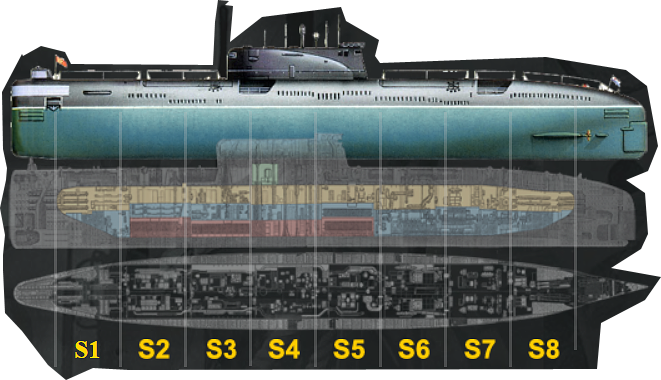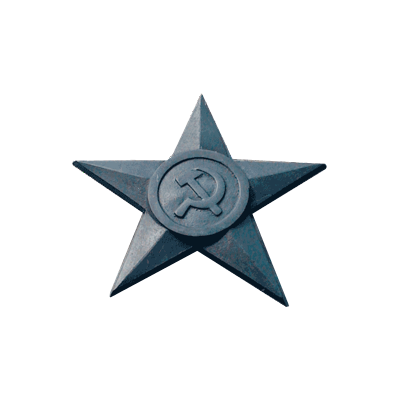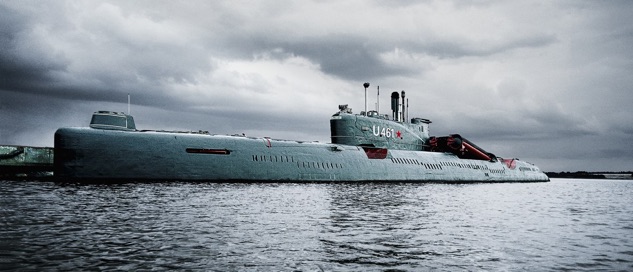Submarine JULIETT U-461
The Maritim Museum Peenemünde is located on Usedom, Germany’s sunniest island in the Baltic Sea. More at www.peenemuende.com
The island of Usedom can be reached in 2-3 hours by car from Berlin. It is also very easy to get to any seaside resort on this island by train.
Here you will find the famous imperial resorts of Bansin, Heringsdorf and Ahlbeck.
In the Peenemünde area, also known worldwide as the „cradle of space travel“, there is not only the world’s largest submarine museum but also the Historical Technical Museum „HTM“. There, interested visitors can learn about the history of the first ballistic missile „A4“, later called „V2“, which was developed, built and tested in the army testing facility at the Peenemünde-Ost plant.
MARITIM MUSEUM • PEENEMÜNDE • USEDOM ISLAND • MECKLENBURG VORPOMMERN • GERMANY

CONSTRUCTION
Section 1
forward torpedo room, crew living quarters, equipment room
Section 2
Officers‘ chambers, officers‘ mess, battery compartment
Section 3
Aerials, captain’s cabin, periscopes and control devices
Section 4
Steering and control room, Navi-acoustic- and Radarschapp, radio room
Section 5
Engine controls, Galley, shower, Batteries
Section 6
Diesel Main- and auxiliary machine, Fresh-Air and Exhaust Mast
Section 7
Electric controls, E-main engines , cold storage
Section 8
Aft torpedo Room, reserve torpedos, E-Schleichfahrt engine
HISTORY
The 50s
The conventionally powered submarine U-461 of the former Baltic red banner fleet belongs to the project 651 class, NATO reporting name JULIETT. By the end of the fifties this class of submarines was developed to counter enemy surface targets, especially US aircraft carrier-fight croups. Of the initially planned 72 units only 16 were actually built. The rest was canceled due to the forced production of nuclear-powered submarines.
The 60s
U-461 was built in the early 60s and was commissioned in 1965 in the Soviet Navy. Exercise- and patrol journeys with sharp weapons followed in the North Atlantic. Units of the 35. U-boat division undertook many long time enterprises far away from the home bases, exceeding the projected autonomie of 90 sea days by far. The submarines of the JULIETT-Class carried four nuclear-capable anti-ship criuse missiles in four containers. They only could be launched while the submarine was surfaced, a very risky undertaking.

The 70s
While patroling they used the snorkel to stay submerged. The boat was usually driven at approx. 8m depth, running its diesel engines under the surface by drawing air trough a tube (the snorkel) from the surface. After a long sea deployment in the Northern Baltic Sea, the officers and sailors of the nuclear-powered submarines always smiled about the crews of the JULIETTs: from the tower hatches rose men, smelling of oil, diesel and sweat, carrying their dirty board packages. No comparison to the nearly „shirt-sleeve-atmosphere“ of the Soviert nuclear submarines.
The 80s
At the beginning of the 80s the remaining units of the JULIETT class were temporary put out of service, only to be reactivated in 1985. NATO-Intelligence states that of the 6 serving units in the Red Banner Fleet only 4 were actualy in active service, while the other 2 were held in reserve status. The boats were exanged after a certain time. From 1988 on the units of the JULIETT class generally stayed in reserve status.
The 90s
Almost at the same time after the successful independence attemps of the Baltic States from the USSR, the prevailing part of the boats of the Baltic Sea Fleet were decommissioned. In 1994 two demilitarised JULIETT boats have been sold or leased to museums in Germany and the U.S. In December 1998 U-461 came about detours under the direction of Mr. Thomas Lamla with the aid of two Tugboats to Peenemünde on Usedom in Mecklenburg Western Pomerania. Moored at the pier of the former naval base of the 1st Flotilla, U-461 JULIETT is a magnet for visitors and naval enthusiasts from far and wide.
PEENEMÜNDE
The Maritim Museum Peenemünde is located on Usedom, Germany’s sunniest island in the Baltic Sea.
More at www.peenemuende.com and www.kartbahn-peenemuende.de
The island can be reached from Berlin in about 2 hours by car via the new A20 motorway. You can also travel very comfortably by train to every seaside resort on this island. Here you will find the famous imperial resorts of Bansin, Heringsdorf and Albeck.
In addition to the U-boat Museum, Peenemünde is also home to the Historical Technical Museum „HTM“ – the cradle of space travel. Wernher von Braun developed the German A4 (V2) rocket at this site.
OPENING HOURS OF THE MARITIM MUSEUM (overview)
see current opening hours here
16. Sept – 15. Okt 10.00-16:30 Uhr | 01. June – 30. June 10.00-17.00 Uhr
16. Okt – 31. May 10:30-15.00 Uhr | 01. July – 15. Sept 09:30-18:15 Uhr
see current opening hours here
Opening hours of the U-Boat Shop in Peenemünde
16. Sept – 15. Okt 10.00-16:30 Uhr | 01. June – 30. June 10.00-17.00 Uhr
16. Okt – 31. May 10:30-15.00 Uhr | 01. July – 15. Sept 09:30-18:15 Uhr
Closed in November, January and February. Open weekends and holidays in December and between holidays.
or on the web: U-Boot Shop Online
How to find us
see current opening hours here
From the Berliner Ring A10, take the A11 towards Stettin.
At the Ueckermark junction, take the A20 towards Stralsund.
Take the Gützkow exit in the direction of Wolgast / Greifswald-Süd,
over the bascule bridge „blue miracle“ onto the island and as far as Bannemin.
Turn left at the traffic lights and follow the signs to Peenemünde.
In Peenemünde, go directly to the harbour or submarine.
Distance from Berlin approx. 225 km
Current price and travel information can be found here.
Distance from Berlin approx. 225 km
Maritim Museum | Peenemünde Main Harbour | 17449 Peenemünde
Tel. 038371-89054 | Fax 038371-26581
Hotline main harbour: 0700-47473333 (0,12€ from the German fixed network)











